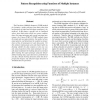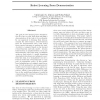3643 search results - page 79 / 729 » Learning Submodular Functions |
ALT
1999
Springer
15 years 2 months ago
1999
Springer
Abstract. Blum and Blum (1975) showed that a class B of suitable recursive approximations to the halting problem is reliably EX-learnable. These investigations are carried on by sh...
79
Voted
ICPR
2010
IEEE
15 years 1 months ago
2010
IEEE
The Functions of Multiple Instances (FUMI) method for learning a target prototype from data points that are functions of target and non-target prototypes is introduced. In this pa...
80
Voted
ICML
1997
IEEE
15 years 11 months ago
1997
IEEE
The goal of robot learning from demonstration is to have a robot learn from watching a demonstration of the task to be performed. In our approach to learning from demonstration th...
103
click to vote
CVPR
2009
IEEE
16 years 5 months ago
2009
IEEE
We address the problem of label assignment in computer
vision: given a novel 3-D or 2-D scene, we wish to assign a
unique label to every site (voxel, pixel, superpixel, etc.). To...
93
Voted
GECCO
2006
Springer
15 years 1 months ago
2006
Springer
1 Learnable Evolution Model (LEM) is a form of non-Darwinian evolutionary computation that employs machine learning to guide evolutionary processes. Its main novelty are new type o...


